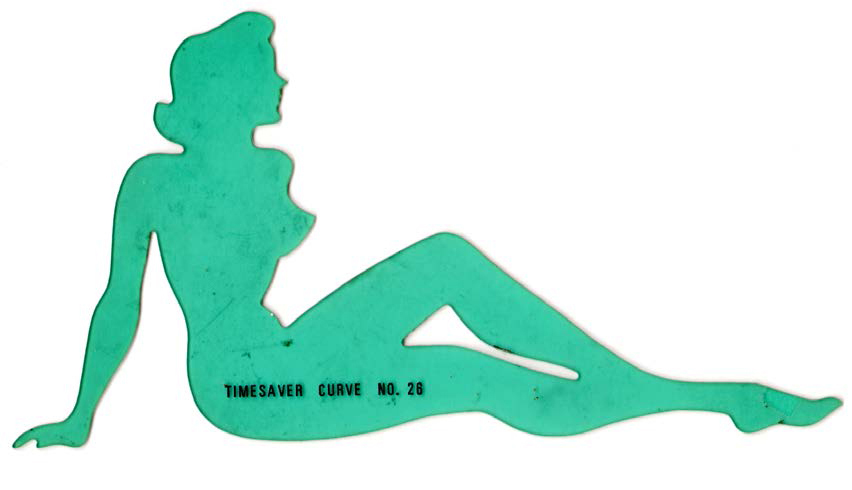
For most of the last century, there was a little inside joke/private naughty gag sold through the companies that made plastic templates—those gizmos that let you trace circles and shapes (they also made protractors and triangles and stuff). I don’t rightly remember which company promoted the most, but the usual promo model was made of that transparent green plastic stuff. It was sold as a “French curve” and it was a silhouette of a reclining nude woman. Get it? (Nudge nudge, wink wink.)
No self-respecting draftsman in the entire country would be caught dead without his official French curve hanging push-pinned to his workspace wall. It was like a badge of honor for generations. It showed you “weren’t no wimp,” instant bonafide manliness.
I can remember all through my childhood, whenever I’d walk through an architect’s office or an engineer’s office or an industrial designer’s office or a simple draftsman’s cubicle, there was always one slapped up somewhere. The dirty young men working there would point at it and say, “Hey, kid! That’s a ‘French curve!!!’ haw! haw!” It was like some sort of clockwork ritual I saw over and over. That stupid gag was so popular that the template companies listed it as a big seller for over 50–60 years, easy.
How did it transit from naughty draftsman humor to trucker logo?
Here’s my theory: designers don’t make logos—culture makes logos. Designers just document. We just are the hand that scribbles the logo into existence. If we do our jobs right, the logo has already been designed by our shared collective culture. We just have to nudge it out.
And even when you’re wrong, and really haven’t nailed that logo down? The culture will MAKE it right. Basically, if the cultural mindset is strong enough, it will MAKE that squiggle reflect what we want it to reflect. Thus a “French curve” LEARNS to say “trucker.” The designer didn’t put that there, the culture did.
My thought is that, while working on some aspect of designs for the new Kenworth or Peterbilt truck models at their plant, some wiseass made a crack about what great joke it would be to put a “French curve” on a trucker’s mud flap. Or, maybe there was even some trucker walking through the draftsmen bullpen and saw one hanging up and made a crack about it. At any rate, that little bit of graphic language assimilation happened in a sweat box of creative thought—the bored draftsman’s fevered mind.
My point is that the visual language somehow made that big step into another culture’s mindset, its self-definition. It became assimilated by underground trucker subculture through contact with American industrial design subculture. That’s where it rubbed against and stuck. Once the little chrome icon was stuck on a truck, the change was almost explosive. It was adopted so whole-heartedly by the graphic visual language of the trucker subculture (and the larger mainstream culture looking in at the trucker culture) that the older, more established long-term drafting “French curve” gag was lost and forgotten. You have to go back to older generations of designers before you will find somebody who remembers the “French curve,” but EVERYBODY knows the trucker mud flap girl.

Isn’t it fascinating how this stuff works?
This is the tip of an iceberg. This sort of transference happens again and again and goes virtually unnoticed by the academics who chart and document this graphic language. The official historical position on this sort of thing is that some lone genius sat down and DREW IT into existence, then sold it and christened that image as the trucker logo—through sheer genius. It makes no accounting that some of the most famous (and infamous) images in our shared graphic vocabulary began life in totally different contexts than we could ever imagine. Somehow the culture we all share managed to change the meaning of that visual language image into a totally new definition—just like a real word!
